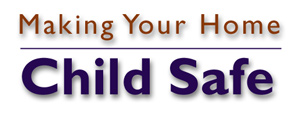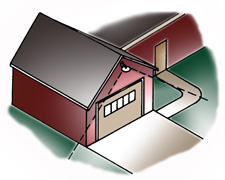 |
||
 |
||

|
 |
||
 |
||

|
 As a parent, from almost the moment
your first child is born, you begin to worry about his/her health and safety.
As a parent, from almost the moment
your first child is born, you begin to worry about his/her health and safety.
Worry though you will, the only truth about childhood safety that you have to remember is that ACCIDENTS DO HAPPEN. The normal, active, physically healthy child will occasionally have some cuts and bruises.
The key is to keep your child from serious and preventable accidents and injuries. You don't want your child to become part of the national statistics on childhood injuries.
The National Center for Health Statistics says that children under 14 are seven times more likely to die from an accidental injury than a homicide. However, many parents have the misconception that violent acts (things over which they have no control) such as kidnappings, shootings and drugs pose greater dangers to their children than injuries, according to polls. Nonetheless, injuries are the number one killer and disabler of children.
Today there are things parents can do to control the impact of many injuries. One out of every four children suffers a preventable injury that requires medical attention. There are things that can be done to prevent these kinds of serious injuries.
It is for that reason that this document has been written. It is meant to be a primer, not an all-inclusive manual on childhood safety. Use this document as a starting point, perhaps obtaining more information from other resources on the subjects in which you are most interested.
|
|
PREVENTING INJURIES INSIDE THE HOME
Childproofing your home should begin prior to your child
learning to crawl because once he/she becomes mobile, you are faced with
an ever-increasing, intensely curious whirlwind of activity. Inspect your
home while you have the time to do it thoroughly.
Childproofing does not mean moving breakables to higher shelves. It
means locking, securing, relocating or removing anything that may pose
a potential danger to a child. Young children are very tactile and oral;
consequently, any new object or substance must not only be touched but
mouthed to be fully explored.
Use the following checklist as a starting point for childproofing your
home.
In the kitchen and bathroom–
In other areas of your home–
In addition–
Remember, childproofing is not a 100 percent guarantee that your child
will be safe from injury. It is not a babysitter. Parents must still be
vigilant. At best, childproofing slows down the curious young child.
|
|
|
PREVENTING INJURIES OUTSIDE THE HOME
It seems that children injure themselves more outdoors than
indoors. And parents sometimes mistakenly assume this happens because there
is very little they can do to control the outdoor environment. However,
there are things that can be done, especially around swing sets, play yards
and swimming pools.
First and foremost, however, ALWAYS use a child safety restraint seat
when riding in the car. Automobile accidents are the number one killer
of children. There is no excuse for not using one. Today, most states
require the use of safety restraint seats. The cutoff age varies from
state to state.
Next review these checklists for suggestions around your home and beyond.
In the backyard–
In the play area–
Built or purchased play equipment should meet the following basic
safety requirements:
In the pool area–
Drowning can happen in a matter of minutes and it doesn't matter if
you have an in-ground pool or small, child-sized wading pool. Some basic
rules are:
|
|
|
PREVENTING INJURIES AWAY FROM HOME
Going to and from school, visiting friends, participating
in school activities and a myriad of other things will take your child further
away from your care as he/she gets older.
A bicycle is one way children from approximately age 7 and older get
around. Here are a few basic bicycle safety tips:
In general, you and the other adult members of your household should
learn CPR and be trained in basic first aid techniques. Keep a first aid
book on hand for reference.
National SAFE KIDS Campaign, 111 Michigan Ave. N.W., Washington, DC,
20010.
Local Poison Control Center
National Crime Prevention Institute, University of Louisville–Shelby
Campus, Burnhaus Hall, Room 134, (502) 588-6987.
National Safety Council, 444 N. Michigan Ave., Chicago, IL, 60611, (312)
527-4800.
Local library for reference books and other local resources.
Local hardware stores, home centers or bookstores for books such as
Sunset's Children's Play Yards, which contain information on outdoor safety.
|
|
|
|
| Child-Resistant Cabinet | Toilet Lid Locks |
| Child-Resistant Doorknobs | Stairway Gates |
| Locking Storage Cabinets | Screwdrivers |
| Shovel | Wheelbarrow |
| O-rings | Soft Swing Seats |
| Wood Chips | Pea Gravel |
| Buoyant Life Ring | Smoke Alarms |
| Gate Locks | Keyed Locks |
| Electrical Outlet Covers | Doorstops |
| Locking Metal Boxes | Electric Drill |
| Hammer | Paint Scrappers |
| Fill Dirt | Pliers |
| Screw and Bolt Caps | Sand |
| First Aid Kit | Pool Alarm |
| Self-Latching Gate Latches | Cordless Phone |
Check your state and local codes before starting any project.
Follow all safety precautions. Information in this document has been furnished
by the National Retail Hardware Association (NRHA) and associated contributors.
Every effort has been made to ensure accuracy and safety. Neither NRHA, any contributor
nor the retailer can be held responsible for damages or injuries resulting from
the use of the information in this document.